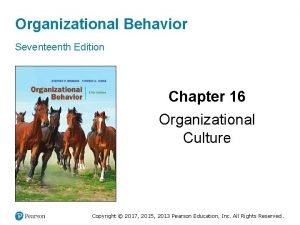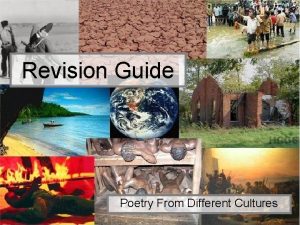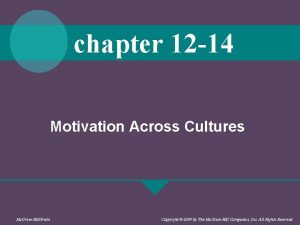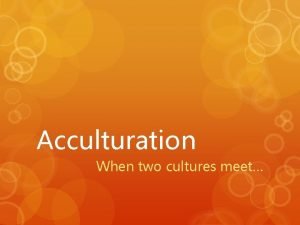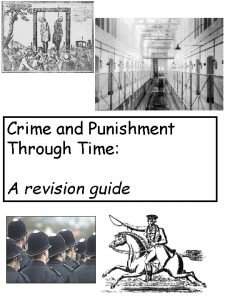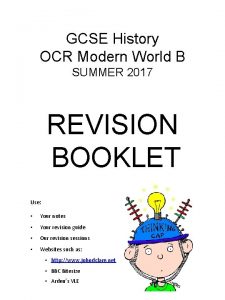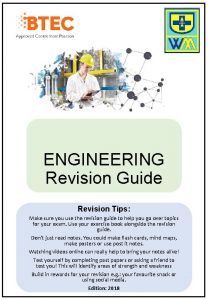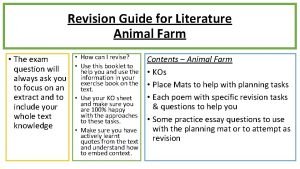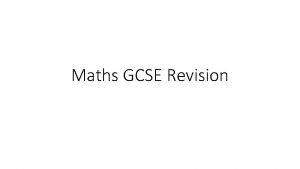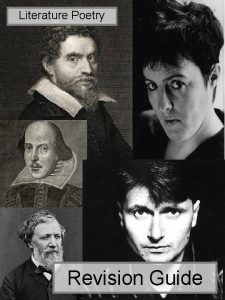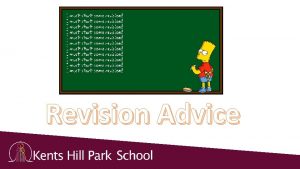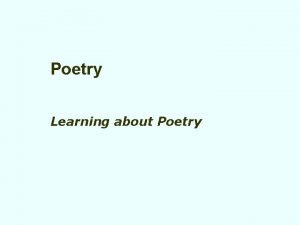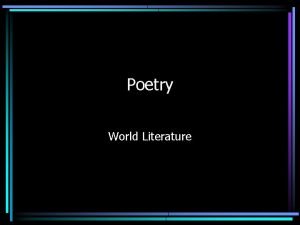Revision Guide Poetry From Different Cultures Advice Preparing










- Slides: 10

Revision Guide Poetry From Different Cultures

Advice – Preparing for the Exam • You will be asked to compare two poems in your exam. One poem will be named (you have to write about it) and you will be asked to compare this to one other poem. • You have 45 mins to complete this. Practice spending 5 mins planning and timing yourself writing a structured response. • You MUST revise. You have a wealth of materials available and you are capable of doing better than you imagine if you revise!

Advice – How to Read a Poem • Look for patterns, repetitions, repeated words, phrases, ideas – and developments of these in the poem (maybe draw pencil ‘arrows’ between them) • What links can you make between the title and the actual words of the poem? Pick out and list some specific vocabulary. Make a note of line numbers. • What word ‘pictures’ or images can you find within the poem? Use circles in the margin to mark them • What do you notice about the punctuation and organisation of the poem into lines and verses? Where does your eye tell you to stop? Where does the punctuation tell you to stop? Count the sentences; count the lines; count the stanzas. • What do you notice about the ‘shape’ of the poem? What does it look like on the page (this is called form or structure). Write some very brief notes to show the poem is organised.

• • Advice – Structuring a Response Highlight key words Brainstorm ideas Plan Write using the following structure: 1. 2. 3. 4. 5. Write about the structure in both poems Write about meaning in both poems Write about imagery in both poems Write about language in both poems Write about emotion / your response / conclusion • Check over your answer

Advice – Writing a Response • If you follow the advice you have been given about how best to plan and structure an essay on the Poems from Other Cultures you should know roughly what ideas and points you are going to cover in each of your paragraphs before you begin writing the essay. In general, each paragraph should deal with one main topic or idea and it may be helpful if you include the following elements to each paragraph. – An outline of your argument or point (this should really refer to key words in the question or address issues which it raises). – A quotation and/ or other detailed reference to the poem named in the question which will support your point. – A comment on the quotation which will help to explain why you have chosen it and may analyse the language in it. – A point of comparison between the named poem and one or more other poem(s) from the cluster (you could try to draw comparisons and contrasts between poems throughout the whole paragraph). • Remember that you will need to indent, or leave a line between, each paragraph and a paragraph should usually contain more than one sentence.

Skills Descriptors Mark Band Statements 7 -9 marks (notional F) §some simple comment supported §reference to appropriate detail §statement on some aspects of presentation 10 -12 marks (notional E) §extended unsupported comment §generalisation on the text(s) as a whole §appropriate reference use of quotation §simple comment on some aspects of presentation 13 -15 marks (notional D) 16 -18 marks (notional C) §some extended supported comment §range of comment supported by textual details §comment on effect(s) achieved by writer §awareness of feeling(s), attitude(s), ideas §effective supporting use of textual detail §some cross reference §awareness of authorial techniques and purpose §understanding of feelings, attitudes, ideas 19 -21 marks (notional B) §effective use of textual detail with integrated cross reference §understanding of a variety of writer’s techniques §appreciation of feelings, attitudes and ideas 22 -24 marks (notional A) §references integrated with argument §analysis of variety of writer’s techniques §exploration of and empathy with writer’s ideas and attitudes 25 -27 marks (notional A*) §conceptualised response §close textual analysis §consistent insight and convincing/imaginative interpretation Content Descriptors Mark Statements 7 -12 marks §accurate account of content of one or more relevant poems §identification of some idea(s)/feeling(s) about the cultures §simple comment on some aspects of presentation §response evident in expressed opinion(s) founded on texts 13 -18 marks 19 -21 marks §some focus on ideas and feelings about culture(s) in two poems and presentation of them §comments on methods of presenting ideas and feelings by means of detail from the poems §personal response evident in comments demonstrating awareness/understanding §examination and analysis of methods of presenting ideas and feelings about culture in two poems §examination and analysis of specific methods of presentation of ideas, demonstrating their effects and effectiveness §integrated comparative approach, analysing and developing own response

Grade A Response (23 Marks) The two poems that I am going to compare how places are presented in them are Nothing’s Changed and What were they Like. These two poems are both writing about very similar places; places that had suffered oppression, racism and death. Nothing’s Changed is written about South Africa soon after the apartheid was lifted. The country had been in a state of segregation for a decade and as a result there had been riots and civil unrest among the blacks and fierce oppression by the whites, this was a place very like a warzone, which leads into the second poem What were they Like? This poem is set in Vietnam soon after the war. The country had been devastated by a bloody conflict with the USA which had resulted in an awful human cost. The USA also devastated the country with horrific weapons of mass destruction. The new weapon napalm was used to burn villages and many lives in Vietnam and South Africa were both ruins and its peoples were angry as is shown in the language of the two poems. Both these poems are full of bitterness. The black poet who wrote Nothing’s Changed uses a vicious irony “we know where we belong” to show that he feels blacks and whites will never truly reconcile. His pent - up rage is expressed again in the final stanza “ Hands burn for a stone, a bomb to shiver down the glass”. This shows the frustration of the place and, possibly, the loss of solidarity, the fears among his people. Afrika’s sense of injustice is powerfully highlighted with the effective imagery of the “purple flowering amiable weeds” and the nefarious “crushed white ice; the single rose” which he turns into symbol of white oppression. The ending is stark and poignant as he feels those old feelings of oppression as his hands burn for a bomb to “shiver down the glass”. This shows even though politics tries to change things, hatred takes a long time to fade. What were they like is also a poem of bitterness. The poems unusual format draws in the reader to the Q and A format. The poems mocking politeness is an effective illustration to the sadness and bitterness of the poem, “laughter is bitter to the burned mouth”. Both poems use this bitterness to show their places as places of shattered dreams and broken hopes. By using words and phrases like , “but after the children were killed, there were no more buds” and “Sir their light heart turned to stone, it is not remembered”. These build up a picture of a desolate place of death and bitterness so startlingly similar to Nothings Changed. The ideas of the poem are reflected in the locations and vice- versa. The themes of death, racism, hatred and bitterness are starkly shown in these two seemingly hopeless places. In Nothing’s Changed the land the new restaurant is used as imagery to highlight themes and in What were they Like aspects of the local culture are used to show much has been lost and how hard a lifetime of bitterness and oppression is to reconcile.

Meaning § what is the poem about? § who is the speaker? - are they dramatized (a character) § who is being spoken to or addressed? § what is being spoken about? § Theme(s) of the poem - what is it really about? § Setting/culture - where’s the poem set? Culture it is from/about? § where does the poem “get to” from start to end? Structure § Rhyme - is there a rhyme scheme? Couplets? Internal rhyme? § Rhythm - how many syllables per line? Is it regular or free verse? Why SMILE Always link everything to theme/subject. Ask yourself how does this contributes to the meaning? Why has the poet used this technique? Emotion § How would the poem be spoken? (angry, sad, nostalgic, bitter, humorous etc) Language are some different lengths? § Stanzas - How many? How do they change? Is there a narrative? § Lines - how many are their in each verse? Do some stand out? § Enjambment - do the lines “run on” to the next line or stanza? § End stopping - does each line finish at the end of a sentence? § Form - does the poem have a shape to it? Imagery § Alliteration - the repeating of initial sounds. § Assonance - is the term used for the repetition of vowel sounds within consecutive words as in, 'rags of green weed hung down. . . '. § Metaphor - comparing two things by saying one is the other. § Simile - comparing two things saying one is like or as the other. § Personification - giving something non-human qualities. § Onomatopoeia - words that sound like thing they describe. § Repetition - does the poet repeat words or phrases? § What kinds of words are used? § Puns - a pun is a play on words - “Shear Class!” if Shearer scores. § Connotation - associations that words have (as "stallion" connotes a certain kind of horse with certain sorts of uses)? § Double meanings - “butts in” - putting bottoms in or interrupting. § Ambiguity - is the word or phrase deliberately unclear? Could it mean opposite things or many different things? . § Word order - are the words in an unusual order – why? § Adjectives - what are the key describing words? § Key words and phrases - do any of the words or phrases stand out? Do they shock? Are the words “violent” or “sad” etc? § Slang or unusual words and misspellings - Does the poet use slang or informal language? Are American words used? § Intertextuality - does the poem reference another text? § Style - does the poet copy another style? (Newspaper, play etc) § Characters - if there are characters how do they speak?

Past Exam Questions • The titles poets give to their poems can often be important. Write about Nothing’s Changed (page 6) and one other poem. Compare the ways the poets use the titles in these poems. • How is contrast used in Two Scavengers in a Truck, Two Beautiful People in a Mercedes (page 8)? Compare this with the use of contrast in one other poem. • Compare the ways an event is described in Blessing (page 7) with the ways an event is described in one other poem. • Compare the ways poets reveal feelings in Nothing’s Changed (page 6) and one other poem. • Compare the ways in which the poets explore the connections between the past and the present in What Were They Like? (page 11) and one other poem.

A poem set at a specific moment in time, looking at two vehicles caught at a red light. What is the poet saying about life in this city? ‘Vultures’ – Chinua Achebe A poem which looks at the possibility that things are not always as simple as they first appear to be. Look at the imagery in the poem. ‘What Were They Like? ’ – Denise Levertov The opening implies that culture is easy to define; the rest of the poem proves that this is rarely the case. Look at the juxtaposition of images in the poem. ‘Night of the Scorpion’ – Nissim Ezekiel A narrative poem in which the persona describes a specific incident. Hindu belief in reincarnation is evident throughout. What do you think the poet is saying about the culture described in this poem? Traditions ‘Two Scavengers …’ – Lawrence Ferlinghetti Presentation Politics The “municipal pipe” bursts in an Indian village and people gather around it. Look at the religious imagery in this poem – is it a blessing? People ‘Blessing’ – Imtiaz Dharker Non-standard English The island man wakes up from a dream of home to “another London day”. Look carefully at the structure of the poem. Metaphor ‘Island Man’ – Grace Nichols Location The persona returns to “District Six” to find that everything is different but “Nothing’s Changed”. Look at the juxtaposition of opposites and the imagery of plants in the poem. Identity ‘Nothing’s Changed’ – Tatamkhulu Afrika First person The persona describes the journey of a slave from Africa to the West Indies in the hold of a slave ship. What is the significance of the title? Description ‘Limbo’ – Edward Kamau Braithwaite Clashing cultures Cultural references Content Change Title & poet
 Characteristics of organizational culture
Characteristics of organizational culture Poetry from other cultures
Poetry from other cultures Revision passive
Revision passive Taste different cultures
Taste different cultures Motivation across cultures
Motivation across cultures What happens when different cultures meet
What happens when different cultures meet Crime and punishment revision guide
Crime and punishment revision guide Ocr gcse modern world history revision guide
Ocr gcse modern world history revision guide Engineering revision guide
Engineering revision guide Animal farm revision guide
Animal farm revision guide Aqa maths gcse revision guide
Aqa maths gcse revision guide
